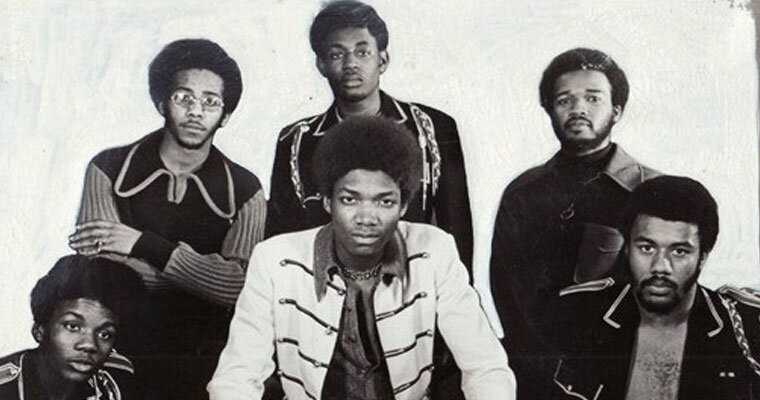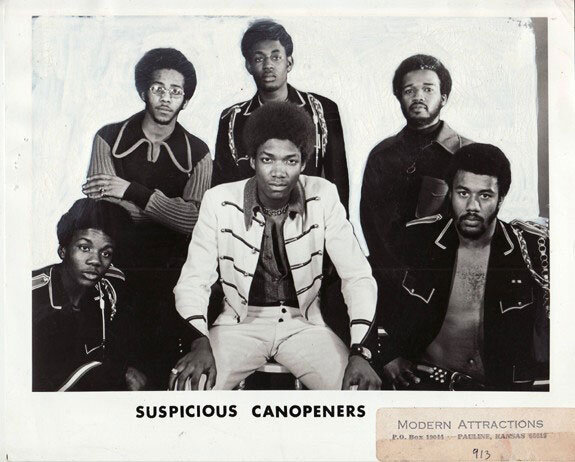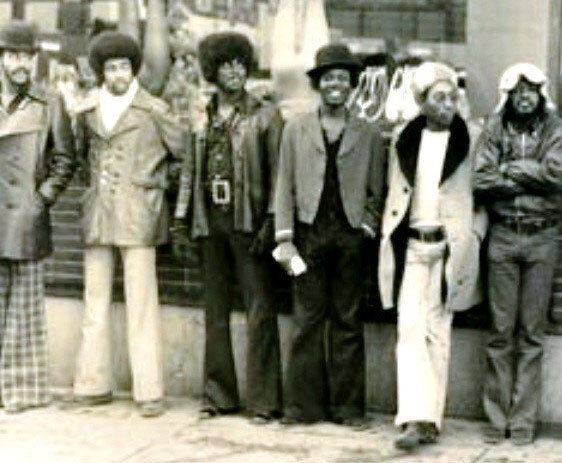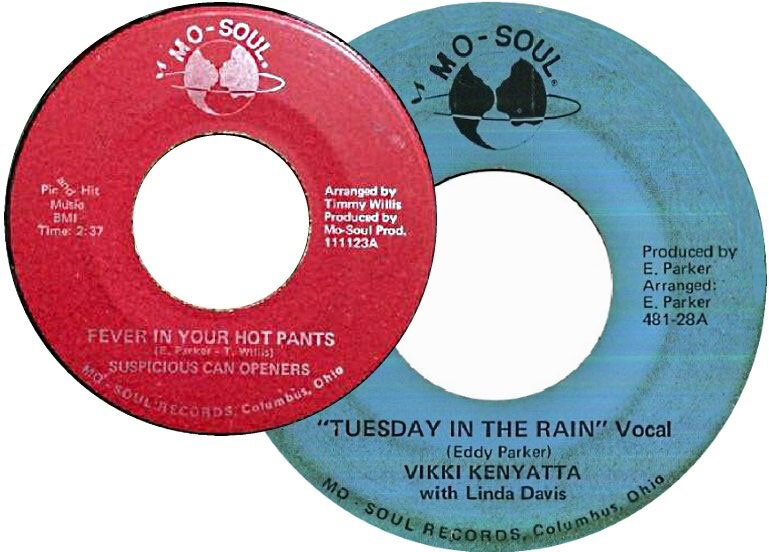Timmy Willis Feature
...such a monumental slab of deep-soul

TIMMY WILLIS
Information about soul vocalist Timmy Willis has always been sketchy but the singer’s “Easy As Saying 1-2-3” is such a monumental slab of deep-soul that I thought a little digging was in order. Of course, the Northern fraternity will doubtless prefer his “Mr Soul Satisfaction” and that’s their prerogative for it’s certainly a fine uptempo stomper.
Timmy was born Henry Lee Sapp in or close to Columbus Ohio (date unknown but probably circa 1947/8). In 1966 the would-be vocalist encountered Eugene and Walter McMahan at the local Preview Lounge, the McMahans being teenage musicians from a large local family (they apparently had 13 other siblings!) who had already managed to secure for themselves a residency at the Lounge. The three guys all soon hooked up, Sapp perhaps wisely changing his moniker to Timmy Willis while his back-up friends were already known as the Show Pushers.
Managed by Roy Hoover, Timmy Willis & the Show Pushers soon made it to Detroit, where, in 1967, they made contact with the local well-respected drummer, arranger and producer George McGregor. McGregor’s interest in music had begun in his early teens at Hutchins Junior High School on the west side of Detroit, where his fellow pupils apparently included Popcorn Wylie, Barrett Strong, Smokey Robinson and Aretha Franklin.
George McGregor says that he cut Timmy Willis’ first recording of the potent "Mr Soul Satisfaction" in Muscle Shoals at his own cost, chiefly to get that southern-soul-horns sound on it. Some say the rhythm section sounds more like a Detroit crew so I guess it’s possible that just the horns were added in the Shoals but this isn’t what George says. Anyway, it’s certainly a great dance record and it would be coupled on a 45 with the plodding and rather gloomy McGregor song “I’m Wondering”. George would take the finished master of “Mr Soul Satisfaction” to Sidra and do a deal with them for it. They duly released it on Sidra 9013 in November 1967 and subsequently licenced it to Veep whose version (#1279) was released in January 1968. The success of this 45 (it made No.39 on the R&B chart and bubbled under the Pop one at No.120) was the reason that George was awarded a position as Sidra’s A&R director.
Timmy Willis -Mr Soul Satisfaction
George knew of the Sidra group called The Precisions from when they were on the D-Town label but he had not yet joined Sidra when their "Such Misery"(arranged by Dale Warren) was released in 1966 on the Sidra subsidiary Drew (#101). Once he himself took charge of producing the group, George decided to base its sound around Billy Prince as lead vocalist and co-wrote "Why Girl" to capture the sound he envisaged. At the time copies of "Sugar Ain't Sweet" c/w "What I Want" had been pressed as promos for the second Drew single by The Precisions but the discs were ‘off-centre’. So, rather than re-master them, George took the chance to get rid of "Sugar Ain't Sweet" which had been put together by Dale Warren as the A side of the single and replace it with "Why Girl". I imagine any spare copies of "Sugar Ain't Sweet" were junked and this is why they are so rare.
Strangely, in another quote (from an interview of George by Soul Source’s Rob Moss), McGregor says “we did 'Such Misery' on Timmy Willis first but then decided to put it out on the Precisions to kinda launch them”. However, if he arrived at Sidra after the Precisions first Drew 45 of the song had been cut he could hardly have been that involved, albeit in yet another quote (this time from his sleeve-notes to a Precisions Outta Sight CD) he says “the first version recorded of ‘Such Misery’ was tried using Paul Merritt (so apparently not Timmy Willis) on lead vocals. He left the group shortly afterwards and his version was not used for the first Drew 45.” The Merritt version was the one much later released on a Joe Boy single, wrongly credited to Timmy Willis due to duff information. This UK single was a year 2000 one-sided commemorative release on JBA-007V3 relating to the Northern Soul nights held at the Lea Hall Social Club in Rugeley in the UK, a long-time local facility, originally opened to serve the area’s coal-mining community.
Joe Boy was a UK indy label run by graphics designer Glenn Gunton, who sometimes used the name ‘Joe Boy’ as his own alias, and who would go on to become a director of the aforementioned Outta Sight Records, along with long-time Northern Soul guru Tim Brown. In 2010, Outta Sight would release “The Sound Of Sidra” CD (OSCD 011) which included Willis’ “Mr Soul Satisfaction” and three Precisions tracks – and later they would release the Precisions CD compilation referred to in the previous paragraph.
McGregor explained to Rob Moss that “Sidra was owned by two white guys, Ray Jackson and Joe Casey, and a black guy Joe Brown. Joe Casey's kids recorded for us. They were called Ronnie and Robyn. Sidra gave me a chance to recruit artists, write and produce, so I got right to it. We had the Precisions, Barbara Mercer, and Timmy Willis and I used Mike Terry to arrange. Our tactics were to see what kinda thing Motown were putting out on the Tempts and then do the opposite with the Precisions – if they put a ballad out we would put something out up-tempo. If they put out something funkier, we would put something smooth out, and it was working. It was driving them crazy over there. Paul Williams and Otis (Williams) of the Tempts told me this themselves. On the third release we kinda got hijacked 'cause Mike Valvano and Charlie Basaline came in and convinced Sidra’s owners to cut one of their songs, 'If This Is Love (I'd Rather Be Lonely)' on the Precisions. It should never have been released as the A side – we should have gone with 'You'll Soon Be Gone'. We lost momentum. I was told later that Motown had paid Mike and Charlie $10,000 to go over to us to wreck the system, by putting their song out on them. The Precisions were as good as the Tempts and should have been a lot bigger than they were. In the end, there was a lot of politicking that destroyed us (Sidra) – I guess that's what Motown wanted.”
Anyway, back in the late 60’s, buoyed by having a modest hit with Timmy’s first 1967 outing, Veep duly put out two more Willis sides in July 1968, this time clearly cut in Detroit, namely “Gotta Get Back To Georgia” and “Don’t Let Temptation (Come Between You And Me)” on Veep 1288, both co-penned by long-time producer (and husband of Kim Tolliver) Fred Briggs and the aforementioned Mike Valvano. The “B” side was a stunning piece of emotional slow-to-mid-paced soul with Willis singing powerfully and impressively, whilst “...Georgia” was a driving piece of swampy funk, again with Willis performing really strongly, albeit things get a tad messy mid-track when he ‘fights’ vocally with the could-be-better girl back-up singers and the tune loses a bit of direction until it returns to its strong main groove. Sadly, though, this 45 failed to chart.
Interestingly, in a August 17th 1968 special Billboard World Of Soul edition, Timmy Willis’ personal manager is listed as Sidra co-owner Ray Jackson with his booking agent shown as Phil Walden, who was of course more usually associated with southern-based singers. However, Timmy stuck with George McGregor as a producer with further writing ventures and recordings duly resulting. George again takes up the story, explaining how he recorded stuff with a view to leasing it to the national labels:
“If I produced a session I usually would not play drums on it 'cause I couldn't see the big picture and might miss something on the recording. At that time, we would cut the session first and then shop it to different companies later. If I came up with songs, I would assemble the musicians on the understanding that if I got a deal they would get a share of it. We had a real tight bond and trusted each other, so there was a lot of honesty amongst us. We supported each other. I would usually go to New York to get a deal 'cause that was the closest and best place to get to the record companies. I got a deal for Tobi Lark at Cotillion (as Toby Lark in 1969 she cut the old Joe Morris-penned standard “Shake A Hand” and McGregor and Mike Valvano’s “Twenty Four Hours”, both sides produced by McGregor, Valvano and King Curtis on Cotillion 44025); Gwen Owens at Jubilee (actually at Josie, the Jubilee subsidiary, Timmy Willis and McGregor co-penning her Josie 1009 August 1969 No.40 R&B hit “Keep On Living”); Rena Scott at Epic (“I Finally Found The Love” and “Testify”, coupled on 1972’s Epic 5-10864, were both produced by George who also solely penned the ‘A’ side and co-penned the ‘B’ side); Almeta Latimore (real name Hattie Almeda Latimer) at De-Vel (“La La” on De-Vel ZS7 6754 from 1973) but we went down to Memphis to record that one 'cause I wanted a different sound. We went to Stax. She was a good writer and had a hell of a voice; Bettye Lavette at Epic (Epic 50143 from 1975 saw one side, “Thank You For Loving Me” penned and produced by George while #50177 from the same year saw one side produced by George and Ron Dunbar, namely Kenny O’Dell’s country-song most associated with Charlie Rich, “Behind Closed Doors”); and Ruby Andrews at ABC (George co-penned and produced 4 of the 9 tracks on Ruby’s 1977 Detroit-recorded album “Genuine Ruby” # AB-1002 having also co-penned and produced her earlier 1976 ABC 12215 single side “I Got A Bone To Pick With You”. From the album, George’s “Queen Of The Disco” also saw 45 release for Ruby in 1977 on ABC 12257 and the same year his “Cinderfella” also made it to the ‘B’ side of Ruby’s ABC single #12286).
But back in the late 60’s, it was McGregor’s connection with Jerry Blaine’s New York label Jubilee that would provide the outlet for Timmy Willis’ own next two 45s. In May 1969 Jubilee put out “I Finally Found A Woman” (#5660), a self-penned, high octane, drum-propelled dancer complete with Pickett-esque screams, the side hitting No.44 on the R&B chart coupled with the pretty impressive country-soul styled mid-pacer “Neveruary” (a track co-penned by Willis and McGregor). Then, in January of the following year, the ultra-deep and absolutely top-drawer piece of emotional soul “Easy As Saying 1-2-3” (#5690) was released and made No.46 on the same chart, coupled with the strutting, powerfully-delivered “I’m A Man”, both these sides being solely penned by Willis.
Timmy Willis - Easy As saying 123
“Easy As Saying 1-2-3” made No.4 in my all-time Male Deep Soul Top 50 and is much-revered by deep fans, not the least of whom was the late, great Deep Soul guru Dave Godin, whose description of the track in his notes to UK Kent’s 1997 CD release “Deep Soul Treasures Volume 1” (CDKEND 143) sums it up perfectly: “ A superb deep church organ opens with a few sparse chords that are soon joined by a sharp and cutting guitar - and Timmy Willis’ exquisitely sweet, light yet rasping tenor declaims the lyrics with an intense and magical conviction. Obviously under the spell of the winning musical formula of the late Otis Redding, Timmy’s voice is actually much more pure and assured. Stunning brass work...cascades across the vocal patterns in an almost independently-minded way and the end result is an outstanding Deep Soul classic....and in order to ease the emotional pain that this presents you with, what do you have to do? Why, spin it again...and again...and again.”
Now, looking at the labels of Timmy’s two Jubilee 45s all one sees is reference to them being Gee-Mac Productions (i.e. George McGregor) with the publishing chiefly in the hands of Jerry Blaine’s Jubilant company. Therefore at first glance they appear to be no more than George McGregor-produced Detroit sides leased out to a New York label for national distribution. However, well-informed southern soul fans, including John ‘Sir Shambling’ Ridley and UK Ace/ Kent regular compiler and annotator Tony Rounce have long been convinced that these sides were cut in Muscle Shoals, with Ridley certain the players on the session(s) were Eddie Hinton, Barry Becket, David Hood and Roger Hawkins. To my ears, “Neveruary” has the most obvious Shoals area sound of all of these fine recordings, a cut which aurally just couldn’t have stemmed from any Detroit studio of the time.
Rounce also suggests that Willis’ second 45 from 1970 could have been cut in the Shoals a year or two earlier than its release date. Now, Willis’ first Jubilee 45 saw release (as already noted) in May 1969 and I personally think both of these sides plus both of those on the second Jubilee release were probably all cut at one and the same Shoals-based session as it seems unlikely to me that George McGregor would send Timmy – a singer with only one small hit under his belt at that time – all the way down to Alabama on two quite separate occasions. It is surely more likely that four or more tracks were cut at this session, four of these seeing release on the two subsequent Jubilee 45s.
However, the next question is - where in the Shoals would such a session have been held? Well, most people would look at the personnel allegedly present (as stated by Ridley) and plump immediately for Muscle Shoals Sound – but that studio had only been opened by the guys soon to be known as The Swampers on April 1st 1969 (this date is confirmed on Page 14 of Section 8 of the MSS entry to the US National Register Of Historic Places, the first time I have found such confirmation as no researchers seem to have suggested a single date before). Of course, April always seemed likely to be the month the studio opened as the first noted visitor to record there was Cher, brought down to Alabama to cut her first solo album at a session commencing on April 21st by Jerry Wexler, who had a major interest in the studio, wanting to retain access to the same Shoals musicians he had recently been using at Fame and having therefore paid towards the cost of its new 8 track system, Atlantic’s engineer-supremo Tom Dowd having first ensured that the proposed MSS set-up would be fully compatible with Atlantic’s own system back in New York.
So if Willis’ first Jubilee 45 was already on the market by May of that year, it is clear that the two tracks on it must have been cut in April or earlier and therefore, whilst they indeed could have been very early products of the new MSS studio, I can now confirm (I believe for the very first time anywhere) that they were not - and that in fact these tracks (and most likely Willis’ other two Jubilee sides, including “Easy As Saying 1-2-3”) were cut at Fame on March 14th 1969, with Eddie Hinton on guitar and David Hood on bass and with almost certainly Barry Becket on organ and Roger Hawkins on drums, as correctly surmised by John Ridley. This confirmation comes from David Hood himself who kept session dates in a book and has come up with this one, albeit from the hundreds of sessions in which he featured he cannot personally recall the occasion. He agrees from hearing MP3s of the tracks that it certainly appears to be Eddie Hinton on guitar - and long-term No.1 Eddie Hinton expert and Zane CD compiler/producer/owner Peter Thompson (who has released all those wonderful Hinton demos on his label and who also kindly contacted David Hood for me) similarly agrees this has to be Hinton.
The one surprising thing is that in his interview with Rob Moss and in his self-penned notes to the Outta Sight CD, George McGregor never once mentions going down to the Shoals in ’69 to cut these particular sides and, seeing as he claims he had done just that somewhat earlier to record Timmy on “Mr Soul Satisfaction”, it seems very odd that he would not mention returning there at this later date.
Anyway, three months after Willis’ “Easy As Saying 1-2-3” left the charts, Jerry Blaine would retire from the record business, selling Jubilee to a company called Viewlex - but as Timmy’s Jubilee outings had only been leases, this didn’t stop the singer hoping for more success, perhaps with other ‘national’ labels with which McGregor already had connections. However, this prospect seems to have come to nothing at this time and Timmy’s Detroit connections were soon more or less severed in 1971 when he returned to his native Columbus, Ohio to rejoin what was essentially an enlarged version of the Show Pushers.
Eugene and Walter McMahan had most likely returned to Columbus from Detroit somewhat earlier, after it had become apparent that their services were no longer required in respect of Willis’ recordings with McGregor; but two of their younger siblings, Jerry and Ronnie, along with three of that pair’s classmates (Ron Johnson, D. C. Collins, and Cornell McLeary) had all got together to form the strangely-and-somewhat-psychedelically-named group the Suspicious Can Openers. On Timmy’s return to Columbus he duly joined this group as their main vocalist, his manager Roy Hoover and Eddy Parker forming a production team, named Mo-Soul Productions. By now this group was a full horn-funk ensemble and it duly recorded a couple of instrumentals, namely the tense funker "Fever In Your Hot Pants", penned by Parker and Willis and the slow "Tuesday In the Rain", penned just by Parker, which was actually a backing track designed for an unreleased vocal, possibly by Willis. This instrumental 45 appeared in 1971 on Mo-Soul 111123, having been recorded at Columbus’ Magnetic Studio.
Around this time a photo appeared of the group:

With six guys in the photo it seems clear that Willis was included in it along with the two McMahan brothers and their three pals and, as he was the featured vocalist and the guy now with three hit records to his name, it seems likely he is the person centrally seated in the contrasting predominantly white outfit. No solo photo of Willis is known to exist in the public domain so this may be all we have - but of course the guys in the photo are not actually named at all let alone by their positions in it - and so we can’t be 100 per cent certain that Willis actually is the guy sitting in the middle.
It’s interesting to note from the sticker attached to the photo that the group’s agency for personal appearances in the early 70’s was based not in Ohio but in Pauline, Kansas and during this period the group regularly played club venues both in their local region and also more widely in the mid-west.
There is another photo of the group, probably taken somewhat later in view of the even bigger Afros and the ‘flares’ being worn, which can be found in the Black History section of the Pinterest web-site. This though is somewhat blurry, albeit 6 guys still feature so Timmy may well be in there somewhere!

Apparently the Can Openers finally disbanded in 1974. However, in that same year, Mo-Soul released another 45, this time by a certain Vikki Kenyatta (with Linda Davis) on Mo-Soul 481-28. This was a vocal version of "Tuesday In The Rain", apparently using the same instrumental recording that had been released by the Suspicious Can Openers. It's possible that the vocal had also been recorded earlier, although whether it is the one that was originally intended to compliment the Can Opener’s backing track is uncertain.

The B side was again a purely instrumental version of “Tuesday In The Rain” apparently credited this time simply to the Mo-Soul Band. According to the Discogs web-site, The Mo-Soul team would next release a 45 on their Kandun label. It seems unlikely that any of the Can Openers were involved as apparently the label credit is simply awarded to the Jupiter's Release Band and, in any event, the Can Openers had probably already disbanded by the time of this recording. The 45rpm records web-site’s list of Ohio label releases includes one further Kandun 102689/102690 release from 1977 by a certain Butch Johnson, which coupled “Everlasting Life (Everlasting Love)” with “Smooth Dancin’”.
During his early 70’s spell with the Can Openers, in 1972 Timmy Willis also managed to secure what would turn out to be his final solo recording session, over on the West Coast and it seems he toured again as a solo act for a while after this release. The 45 on Epic 10934 coupled “Give Me A Little Sign” with “Don’t Want To Set Me Free” and was released in November 1972. Despite a Radio Action and Pick Single reference in the December 23rd edition of Billboard, the 45 never made it to the charts and, frankly, wasn’t quite in the league of his best earlier work. The record was produced by Marlin McNichols and Melvin ‘Wah Wah’ Watson (real name Melvin Ragin and best known as a fine Motown Funk Brothers guitarist) and these two guys got co-writer credits on both tracks along with Willis himself. The sparse staccato funk of “Don’t Want To Set Me Free” is well above average for this genre and the ‘A’ side “Give Me A Little Sign” is a stop-go ballad with a well constructed hook, Timmy certainly giving it the full treatment, especially at the climax when he really cuts loose.
To my knowledge no further information about Timmy’s activities after the mid-70s has ever surfaced but if anyone knows different please help complete the Timmy Willis story.
Peter Nickols
Related Soul Source Articles
-
 4
4


Recommended Comments
Get involved with Soul Source
Add your comments now
Join Soul Source
A free & easy soul music affair!
Join Soul Source now!Log in to Soul Source
Jump right back in!
Log in now!